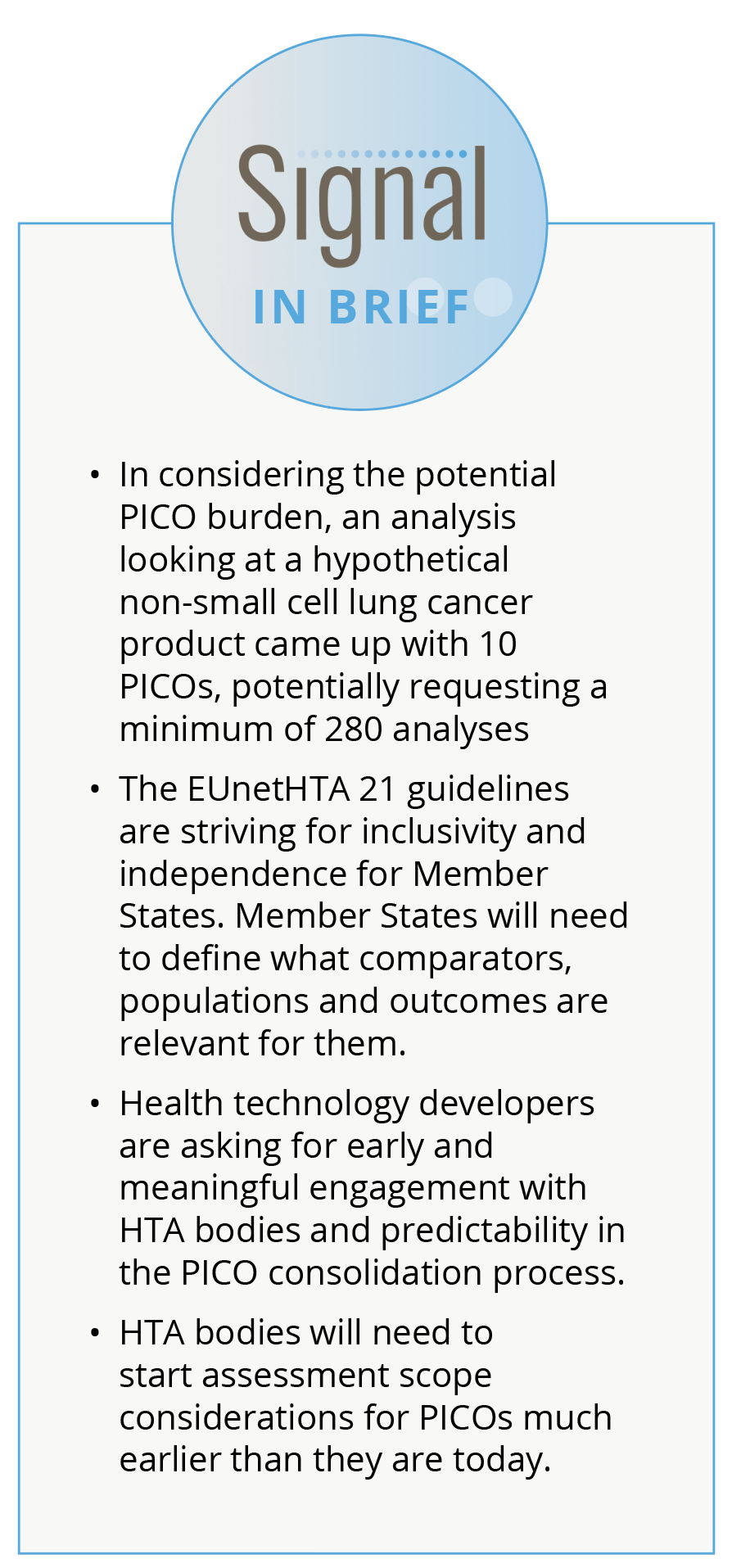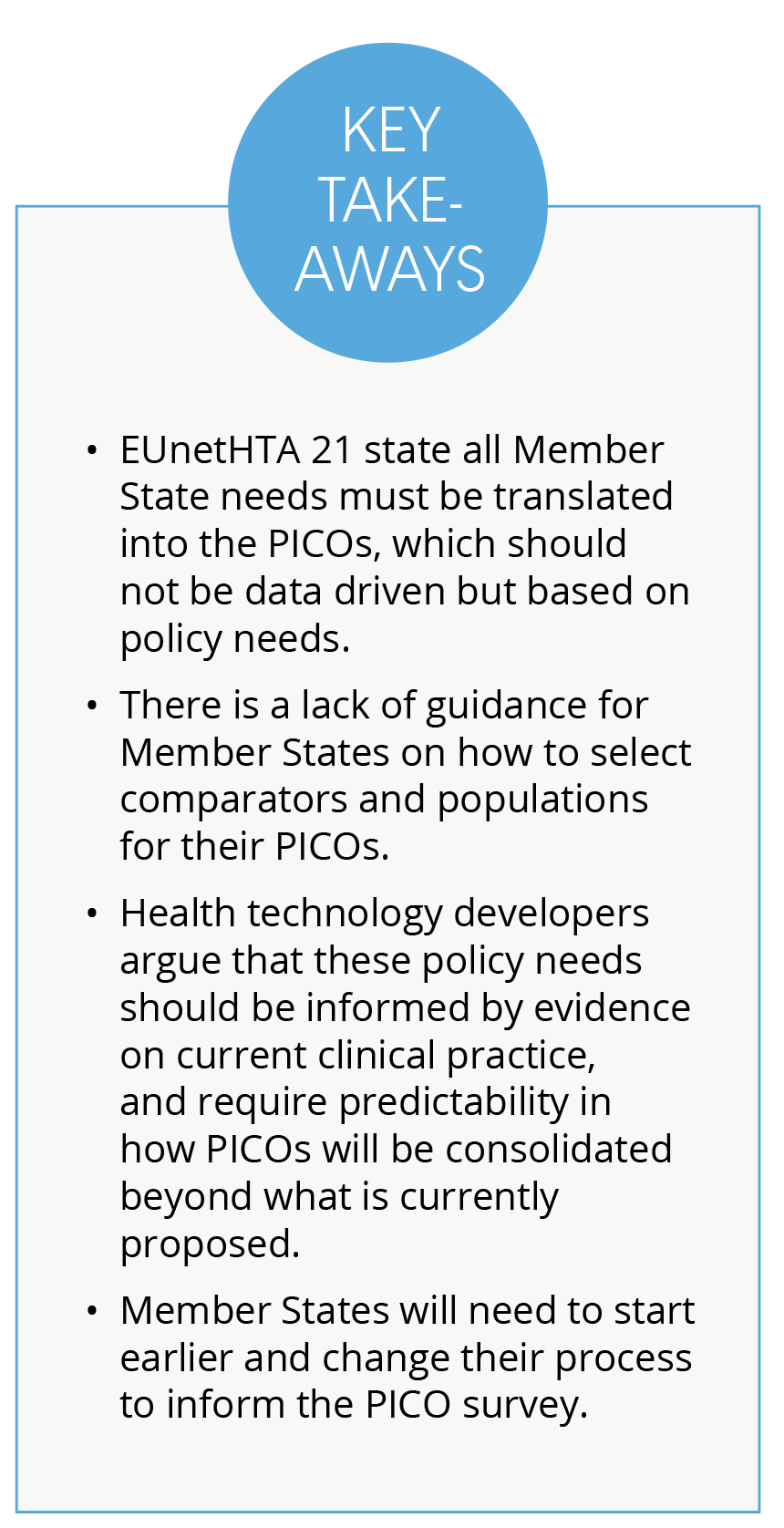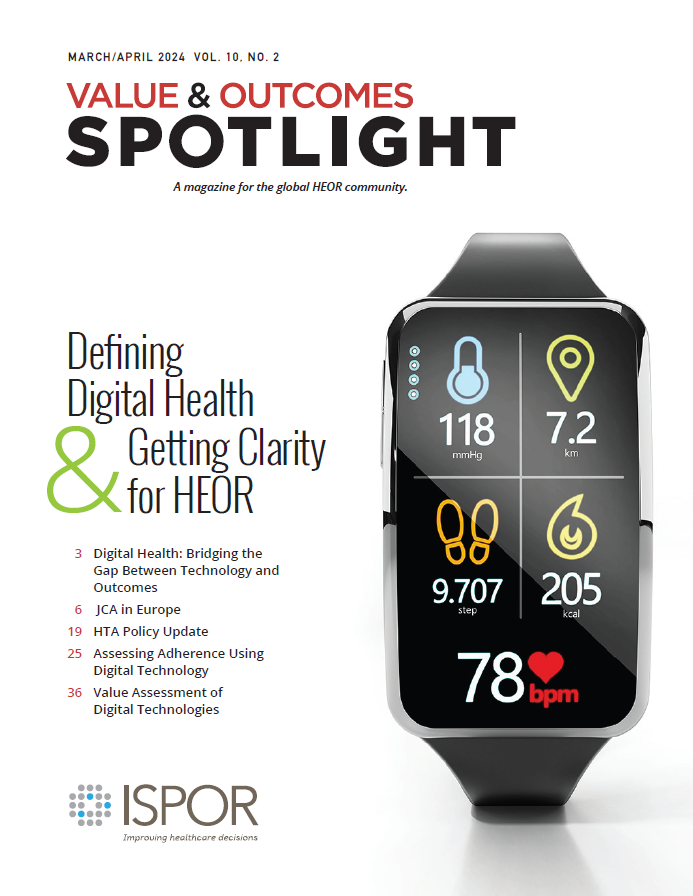No Easy Predictions About the European Union Joint Clinical Assessment
Christiane Truelove

In January 2025, the European Union (EU) HTA Regulation will be applied and start with a phased use of a standardized framework – the Joint Clinical Assessment (JCA) – which all of the 27 Member States will use to evaluate new medicines or medical devices. By reducing redundant practices and introducing a single transparent process, the hope is that the JCA speeds the introduction of innovative technology to patients all across Europe.
The EUnetHTA 21 joint consortium wrapped up its work in September 2023. A special spotlight session at ISPOR’s Europe meeting, EU Joint Clinical Assessment: One for All and All for One in November 2023 examined ways that PICOs [population, intervention, comparator, and outcomes] could be consolidated, presenting perspectives from EUnetHTA 21, government, and health technology developer on the proposed process, methodology, and implications for evidence development. The intent of the session was to address the question of how to develop a JCA scoping procedure that has the most impact and brings value to EU patients.
“I have a dream,” said James Ryan, who represents AstraZeneca on regional and global HTA Policy around the world and is a co-lead on the European Federation of Pharmaceutical Industries and Associations health technology assessment (HTA) Working Group’s methodology workstream on the EU HTA Regulation. “Imagine what a world-class HTA system would look like. What principles should drive it? How can it make the most impact for patients in a resource-constrained world? Right now the EU has that unique opportunity to develop, implement, and actually deliver the #1 HTA system in the world—one is of high quality, scientifically credible, transparent, and inclusive.”
Ryan dreams about having improved and more equitable patient outcomes across Europe, where decision making is quicker, European evidence needs are prioritized, uncertainty is reduced, and the return on Member States’ constrained resources are maximized across all stakeholders. “Who among us wouldn’t want that? And yet despite this, I don’t actually sleep well,” Ryan said. “In fact, the proposals put forward by EUnetHTA 21 often keep me up at night. I dream PICOs.”
"By reducing redundant practices and introducing a single transparent process, the hope is that the JCA speeds the introduction of innovative products to patients all across Europe."
Defining and Understanding How PICOs Could Work
While EUnetHTA 21 has outlined an approach for the PICO scoping process, it’s only a proposal until the EU adopts the JCA implementing act, currently under consultation, and the Coordination Group finalizes scoping guidance. Under the proposed process, the health technology developer begins by submitting a regulatory dossier to the European Medicines Agency (EMA). Then the assessors will receive the anticipated label and use that information to propose one or multiple PICOs, which is sent out as a survey to all 27 Member States. In the survey, the Members would comment on whether they would agree with the PICO(s) as laid out by the assessors or whether they have other national needs. The assessors would then consolidate all these surveys and come up with the lowest number of PICOs possible, yet enough to meet the needs of all 27 Member States. According to Van Engen, this will result in PICOs with one population, one intervention and one comparator. In the final steps, the EUnetHTA 21 scoping guidance outlines that all the outcomes as requested by the Member States are applied to each PICO and then the PICO would be validated before the consolidated PICO is shared with the health technology developer.
Anke van Engen, managing principal at IQVIA in Amsterdam and leader of the Health Economics/HTA Center of Excellence in the European Value & Payer Evidence practice, led IQVIA’s case study simulating the PICO for a hypothetical product in non-small cell lung cancer to determine what the potential PICO burden could be like. “In non-small cell lung cancer, there were 11 EMA products approved at the time that we did our analysis. The latest product that was approved was nivolumab in combination with ipilimumab and 2 cycles of platinum-based chemotherapy. We assumed that ‘Product X’ had an equivalent trial design as nivolumab and used the same patient population, same comparator, and the same study endpoints. We then looked at the clinical guidelines, the ESMO (European Society for Medical Oncology) guidelines, and national clinical guidelines, as well as the latest HTA reports,” Van Engen said.
Six of the 27 Member States had a published an HTA report on nivolumab. “Based on this information, we anticipated what each Member State of each country that has an HTA report would fill in for their country-specific PICO(s) and then we applied the EUnetHTA scoping process guidance to come up with consolidated PICOs,” Van Engen said. After consolidating the PICOs, IQVIA came up with a minimum of 10. “We had 9 different populations, 9 comparators. About 5 of the 10 PICOs could be addressed by head-to-head data, yet the other 5 would require indirect treatment comparisons.” Additionally, across the 6 countries that asked for the 5 PICOs, there were 28 outcomes requested—14 clinical outcomes, 9 safety outcomes, and 5 health-related quality-of-life outcomes.
Applying 28 outcomes to all 10 PICOs would result in a total of 280 requested analyses, “assuming there’s only 1 outcome measure and no subgroups requested,” Van Engen points out. But the complexity can grow “exponentially” if, for example, an additional outcome measure or more subgroups, or more detailed safety endpoints are requested. Additionally, when IQVIA included the National Institute for Health and Care Excellence (NICE) in the United Kingdom, an HTA body often referred to by other HTA bodies, the PICO numbers would increase from 10 to 14.
 EUnetHTA and Health Technology Developer View
EUnetHTA and Health Technology Developer View
According to Anne Willemsen, who works for the Dutch National Healthcare Institute (Zorginstituut Nederland) and is now the Co-Chair of the JCA subgroup, the key principles behind EUnetHTA 21 guidance are around inclusiveness and independence. Inclusiveness specifically means all Member State needs have to be translated into the PICOs, and independence means that the PICO should not be data driven but has to be based on policy needs. “I think this is where the controversy lies. But for us it is really important that we come up with a PICO definition that comes from our policy question regardless of what is being studied,” Willemsen said. “We know and we accept there may be questions that cannot be answered. But for us it is important to have those outlined.” The population in the PICO would either be the full patient population or subpopulations defined as part of the full population. Willemsen added that Member States need to be as detailed as they can, “because this is really critical information, we need to be able to consolidate the PICO in the end.”
Willemsen stressed that the Member States need to CLEARLY define what comparator is relevant for them. “The standard of care is often different in each country, therefore we need Member States to specify this in detail,” she said. She added that one of the important learnings in EUnetHTA 21 was finding out each country and HTA body may use terms differently.
According to Ryan, the more than initially predicted number of PICOs in the test study and the lack of engagement and evidence-based guidance on how to develop PICOs at a Member State level are causes of concern for health technology developers. “That produces uncertainty for us all. It leads to variation and duplication across Europe. And what the HTA bodies tell us about uncertainty—they don’t like it,” Ryan said.
Ryan noted the EUnetHTA 21 process proposes an “exponential number of analyses,” with potentially more complex indirect comparisons, which he believes will be the norm and not the exception. He refers to this “analysis paralysis.” As part of the solution, Ryan calls for HTA bodies to have “early and meaningful engagement” with health technology developers that should take into account the data health technology developers collect about a disease, the disease context, clinical practice across all Member States, and endpoints. “Why would a HTA process not want to capture that as part of their thinking? They’ve got to remain independent, but it’s evidence. Engagement and sharing evidence will also reduce duplication for us, and it can increase trust across the whole process down to Member States and, ultimately, to patients,” said Ryan. Health technology developers could also propose a PICO to help as a starting point.
Ryan criticized the lack of guidance for Member States on how to select comparators and populations. “We have guidance on how to interpret data on subpopulations and subgroups, but not in how you go about selecting them for the PICO process. Simply put, the JCA population should be clinically relevant and actionable at a Member State level. If we’re asking things that aren’t clinically relevant, that’s an inefficiency. It’s a waste of resources. Ideally, those should be based on prespecified analyses and trial protocols or on clinical consensus. We should avoid subgroups that are not actionable or actually ignored,” Ryan said.
Ultimately, not all analyses should have the same weight. “We should prioritize those that are required based on evidence and clinical relevance and focus on where most EU patients are covered,” Ryan added.
Getting PICOs Off the Ground in Denmark
Kim Helleberg Madsen, director of pharmacoeconomics and availability of medicines at the Danish Medicines Agency, noted that due to the complex healthcare system in Denmark (which is composed of 4 bodies dealing with decisions in the primary healthcare sector, hospital medicines, medical devices, and vaccines), “we have a lot of coordination to do when it comes to implementing the JCA.”
At the moment, the primary focus is on the methodology and procedural guidelines that are in the pipeline. “The scoping process guideline will be a key document in order to define what we are going to do in terms of PICOs that reflect the clinical practice in Denmark,” Helleberg Madsen said.
He noted that at present, the Danish Medicines Agency receives reimbursement applications for the outpatient sector without any sort of predefined scope. “But health technology developers can reach out and pose questions regarding the assessment scope.”
The Danish Medicines Council receives a request for an assessment from the health technology developer concerning medicines in the in-patent sector which includes a suggestion regarding PICO. However, if the PICO does not correspond to Danish clinical practice, the health technology developer will be informed about this prior to submission of their application.
Throughout the process, the Danish Medicines Council can request additional information. “I think one of the things that we would say in terms of the scoping process, we have to start our assessment scope consideration and have to look into the PICOs at a much, much earlier stage than we are doing today,” Helleberg Madsen stated.
He added that there is also a question of how the EU will fund assessments at the Member State level. “I think our main concern at the moment is to arrive at implementing rules and guidelines that are workable— both for the health technology developers and the HTA bodies—so that we can arrive at a smooth and effective implementation of the HTA regulation.”
Suggested Reading
About the author: Christiane Truelove is a freelance medical writer based in Bristol, PA.

